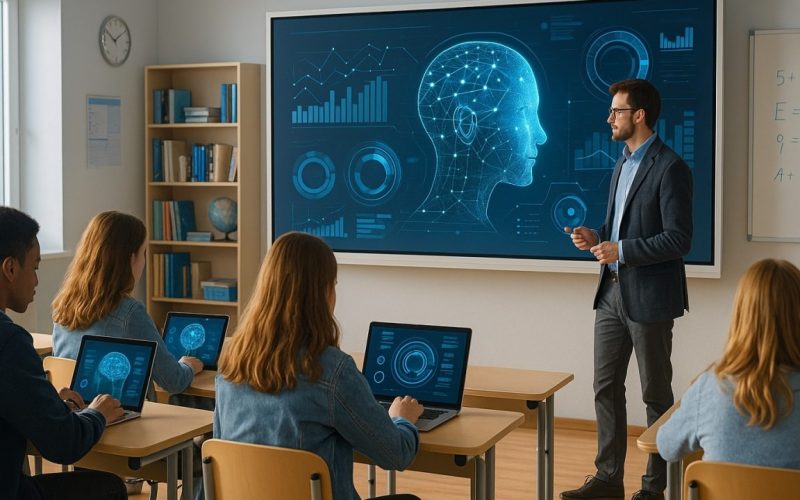Introduction
Education technology (EdTech) brings innovation in the future, and artificial intelligence (AI) will dominate the next wave. AI is no longer a new tool; it is transforming into the backbone of how Edtech defines its growth- transforming how Edtech designs solutions, teachers instruct, and students learn.
It’s no longer a question of why AI integrates into education but how far it may go. Through the Edtech and educational institutions’ experience worldwide, here are the primary AI trends defining the future of education.
What is Artificial Intelligence in Education?
Artificial intelligence means teaching computers to think, learn, and make decisions like humans. In education, AI can analyze data, understand student needs, and offer personalized help. Instead of one-size-fits-all lessons, AI allows customized learning experiences.
With AI, machines can do many tasks, such as grading papers, answering questions, or even detecting when a student is struggling. This frees up teachers’ time and helps students learn better and faster.
How AI is Changing Learning for Students
1. Personalized Learning
One of the biggest benefits of AI in education is personalized learning. Every student learns differently. Some need more practice with math, while others might find reading easy but struggle with science.
AI can track how students perform in real-time and adjust lessons to fit their needs. It creates a unique learning path, helping each student reach their full potential. This means students are not bored or overwhelmed but challenged just right.
2. Intelligent Tutoring Systems
AI-powered tutors are like personal coaches. They provide instant feedback and support outside the classroom. For example, if a student doesn’t understand a math problem, the AI tutor can explain it differently or give extra practice.
These tutors are available 24/7, so students can learn anytime they want. This makes education more flexible and accessible.
3. Language Learning and Translation
AI helps students who speak different languages. It can translate lessons instantly or help learners practice new languages with speech recognition. This opens doors for many learners around the world who might otherwise face language barriers.
How AI Supports Teachers and Educators
1. Automating Administrative Tasks
Teachers spend a lot of time on tasks like grading, attendance, and lesson planning. AI can automate these repetitive tasks, giving teachers more time to focus on teaching and helping students.
2. Data-Driven Insights
AI tools collect and analyze student data, helping teachers understand how each student is doing. This data helps teachers identify students who need extra help and tailor their teaching methods to improve results.
3. Smart Content Creation
AI can help create new lesson plans, quizzes, and study guides. It can even suggest the best teaching methods based on student learning styles and preferences. This makes education more effective and fun.
How AI is Transforming Schools and Education Systems
1. Predictive Analytics for Student Success
AI uses data to predict which students might struggle or drop out. Schools can intervene early with support and resources. This proactive approach improves student success rates and reduces dropout numbers.
2. Virtual Classrooms and Remote Learning
The COVID-19 pandemic showed the importance of remote learning. AI helps create smart virtual classrooms where teachers and students can interact naturally. It can also monitor participation and engagement, helping teachers improve their online teaching.
3. Enhanced Accessibility
AI technology makes education more accessible for students with disabilities. Speech-to-text, text-to-speech, and other AI tools allow students with hearing, vision, or learning difficulties to participate fully.
Trends and Future Predictions
With the further development of AI, its influence on EdTech increases and brings new trends and innovations.
1. Intelligent Production
An educator spends a significant portion of their work developing quality modules. The educators can define learning goals and student profiles, and the AI-based content
The analytics help define the best flows of content and template designs that will work effectively with the help of AI-enabled content development tools. Visualizations provide an increased understanding of content and are stored better in a brain-augmenting content compilation. But do you realize that intelligent content design tools are available to speed up text transformation into visuals? This speeds up the content creation, and learning is more interactive and engages the learners.
In addition, teachers don’t need to store a content database and retrieve necessary data while planning the next academic session. AI works to aid in the automation of data management and generate reusable content while creating.
2. AI is Transforming to a New Type of Infrastructure
There is a big transition in which AI is no longer a bolt-on module and is becoming a critical layer of EdTech infrastructure. AI is no longer a feature and is becoming the backbone of EdTech products and inner operation.
Edtech implement AI directly on their platforms to scale learning experiences. AI-based solutions can interpret student evaluations and dynamically adapt lesson plans individually, instead of a blanket system of products. This change renders education efficient and effective.
However, AI is also streamlining how Edtech work. The functions covered in business activities, including sales and marketing activities, such as forecasting, email marketing, and upselling, along with activities related to finance, human resources (HR), and customer support, are being enhanced with the aid of AI. AI removes the tedious task and provides an entity that can help gain actionable data, allowing the teams to take time to innovate on their product and improve the customer experience.
3. Inclusion and Accessibility
Increased accessibility and inclusivity made possible through the conducive learning environments of learners with special needs and the help to experience education and other learners. Text-to-speech and speech-to-text, motor-assistance, gaze-tracking, and sign-language-assistance technologies change how people with special needs access learning.
Remote socio-emotional teaching occurs in simulated classrooms to enable student and teacher communication. Translations of AI are central in addressing the language barrier between people speaking different languages and can interact easily in the virtual environment in real-time.
4. AI Smart Learning Robots
AI integration into learning and teaching will be more dramatic. Large language models (LLMs) are on the edge of explosive expansion through such machine learning capabilities as natural language processing (NLP) and natural language understanding (NLU).
A teacher can support remote learners only partially because of the schedule limitations. The use of generative AI in LLMs can help learners without a teacher. These applications can also lead students in the LMS to offer interactive lectures, answer questions in real-time, and act as a learning assistant.
Besides, specialized learning is supported using specifically trained bots with in-depth skill knowledge. AI assistants can oversee learning by promoting independence around the clock. This also facilitates a blended learning style.
5. Voice Assistants and Artificial Intelligence Companions
Voice-based AI assistant tools assist the students in scheduling, answering questions, or conducting a hands-free study. Some EdTech startups explore the idea of AI-powered learning companions that interact with the students to ensure learn interactively through conversation, engaging and developing students’ communication skills, curiosity, and critical thinking. They are particularly helpful in foreign language acquisition and early development.
6. Individualized Learning Experiences
Personalized learning using AI is one of the most life-altering changes in higher education spheres. The most unaffected areas of traditional education systems employ the one-size-fits-all model, leaving the rest behind who learn slowly or differently. The application of AI-powered platforms is helping to transform education by analyzing student learning patterns, progress, best and worst subjects, and customizing their learning courses.
Such systems provide extra instruction where a student needs help and advance where goals are achieved, resulting in a more efficient and customized learning process. The method is not only effective in terms of boosting engagement, but also in closing down the learning gaps.
Conclusion
Artificial intelligence is no longer a hypothetical matter in learning, but the reality changes education and teaching methods. There is facilitating individualized learning and intelligent content generation through administration automation and enhanced accessibility by AI. The best way to fully exploit AI is by having educators, schools, and policymakers partner to exercise responsible use, ethical use, and equitable access. Integrating education technology in the classroom is a reality, transforming the future generation’s learning possibilities.












